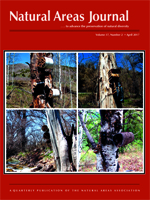Cliffs harbor unique ecological communities while facing increasing pressure from human disturbances. How abiotic factors such as surface heterogeneity, slope, and aspect interact locally to drive variation in plant communities remains largely unknown. We surveyed the vascular plants, bryophytes, and lichens along 50 vertical transects throughout the Big South Fork National River and Recreation Area (Tennessee, USA) to characterize the vegetative community and to determine which factors influenced the distribution of cliff vegetation. Across all cliff face plots, the dominant lichen genus was Lepraria; the dominant vascular plant was Dennstaedtia punctilobula; and the dominant bryophyte was Dicranum montanum. We found several rare species including Cladonia pocillum, a boreal disjunct lichen; Vittaria appalachiana, Appalachian shoestring fern; and Cynodontium schisti, a rare bryophyte. Vascular plants, bryophytes, and lichens were each influenced by different environmental drivers. West-facing slopes supported high vascular plant diversity, low-angle slopes supported high bryophyte diversity, and faces with high surface heterogeneity supported high lichen diversity. Both plant and lichen communities varied widely by transect within and across sampling areas. Recreational rock climbing did not appear to influence community structure, possibly due to low levels of climbing traffic among our survey transects. Nonetheless, we overlapped our vegetative model with a simple spatial model of potential for rock climbing development to highlight specific areas of concern. Our predictive model of vegetative diversity was moderately accurate (ρ = 0.43), suggesting that surveying each cliff individually may be necessary for conservation efforts. In addition, our work indicated that preserving vegetation along the top of cliff faces should remain a focus of conservation efforts.
How to translate text using browser tools
1 April 2017
Cliff Flora of the Big South Fork National River and Recreation Area
Laura M. Boggess,
Gary L. Walker,
Michael D. Madritch
ACCESS THE FULL ARTICLE

Natural Areas Journal
Vol. 37 • No. 2
April 2017
Vol. 37 • No. 2
April 2017
cliff ecology
rock climbing
Shannon's diversity
spatial modeling




